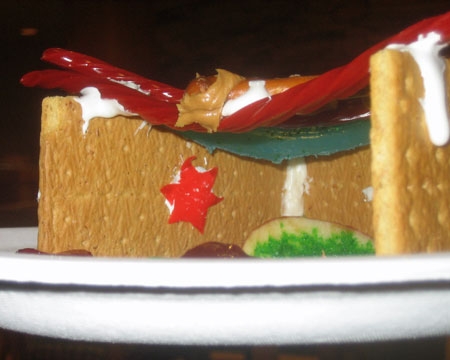What Is A Sukkah?
Sukkot (soo-coat) is a festive Jewish holiday that celebrates the fall harvest, and the shelters, or Sukkahs (soo-kas), which were used in biblical times during periods of wandering by Jews. Beginning October 12th, many modern Jews will celebrate the eight-day-long holiday by building their own Sukkahs at home, often using the structures to host alfresco dinner parties celebrating the harvest.
The beauty of the Sukkah is in its originality, as its builder projects his or her own style into its construction. Whether covered with a roof of pine boughs, a traditional material often used, or something fancier like hundreds of slim planks of wood, it's the perfect place to dine with friends, enjoying a meal filled with fall flavors by candlelight.
While most regular D.I.Y.-ers can create a simple and decorative shelter in the backyard, architects and visionaries have recently taken the concept to a grander level. Last year's Sukkah City contest, in New York City's Union Square, conveyed a notion that the structure can inspire unexpected uses of space, form, and design. Creative contestants with remarkable design talents employed superior imagination. One Sukkah was made from hundreds of thin wooden boards stacked in two directions, creating the communal space. Another standout was the impossible structure of glass walls holding the weight of a massive tree-trunk canopy. Equally visually arousing was the parted, dome-shaped sukkah, filled with sand, and made from plywood, twine, and marsh grass that reaches out in all directions. But you won't find any Sukkahs made of food — it's not allowed. But if you had a spare whale or camel in your yard, that would help — traditional rules would allow the sides of the structures to be made of whale and a floor of camel. Who knew?
Last year's competition has given way to a budding trend, with other cities across the nation planning their own original sukkah experiences. This year, Washington University in St. Louis is hosting their own Sukkah City, inviting designers to re-imagine this ancient dwelling through a progressive lens. Contestants are encouraged to tell a story of "the boundaries that define what it means to be human," says Rabbi Andy Kastner of the Washington University in St. Louis Hillel, using the theme "Defining and Defying Boundaries" to guide their designs. Many will compete, yet only 10 finalists are selected to build their own design. Members of the community will also be encouraged to visit, dine, and celebrate the season within the structures on display.
Click here to see the What is a Sukkah Slideshow.
Can't make it to St. Louis for a dinner party under the stars in a Sukkah? Be inspired by these innovative and unique designs and create your own at home. Follow these steps to making your Sukkah a success, then plan a harvest-themed menu and create a dining experience unlike any other to share with friends, family and neighbors alike.
1. Build the Sukkah
When building a sukkah, the material for the roof should come from the earth, and must reveal openings to the sky so its inhabitants can see the stars from within. Materials like palm branches, bamboo reeds, pine tree branches, and wooden slats are common. The sukkah walls must have at least two-and-a-half-foot sides and are often made of canvas or wood. (Photo courtesy of Flickr/andydr)
To assemble, use two-by-fours to rough-out a box-like space, then affix a painter's drop cloth, shower curtains, plywood, or another material for the sides. Then lash branches or another natural material to the top to create a roof where the sky can still be seen from inside. Not handy with wood and nails? Opt for a pre-made kit that you can assemble yourself.
Still intimidated? Opt for a more kid-friendly building project and make sukkahs using graham crackers, Pretzel Rods, and Twizzlers, all plastered together with peanut butter or cake icing.
Use fruits and vegetables of the fall to add color and life to the inside of the structure. This can range from dried squash, pumpkins of all sizes, even a cornucopia filled with produce, nuts, and flowers. For additional charm, place candlesticks or flowers at the center of the table, and arrange a large bunch of palms, grasses, or bamboo in the corners of the structure for added ambiance. The use of bright colors, either by using colorful yarn or animal-shaped mobiles and children's drawings, will add to the joyful atmosphere. (Photo courtesy of Flickr/Dr. Bacchus)
3. Host a Dinner Party
Hospitality is a key ingredient of a traditional Sukkot celebration. Typically, dishes use plenty of fresh fruits and vegetables, similar to those used as décor. Opt for seasonal foods like squash, apples, and pear when planning the menu. A vegetable medley of stewed peppers, onions, squash, and zucchini cooked with olive oil, garlic, and oregano is a common dish (similar to a tomato-less ratatouille), and good to serve alongside a roasted chicken. Though to represent a bountiful harvest, stuffed foods are also often served — like these cheese-filled figs. And don't forget a sweet finish for any Sukkot meal. A fruit compote with plums or apples or the traditional Jewish pastry, rugelach, filled with raisins, nuts, cinnamon, or chocolate completes the Sukkah dining experience.
Click here to see the What is a Sukkah Slideshow.

